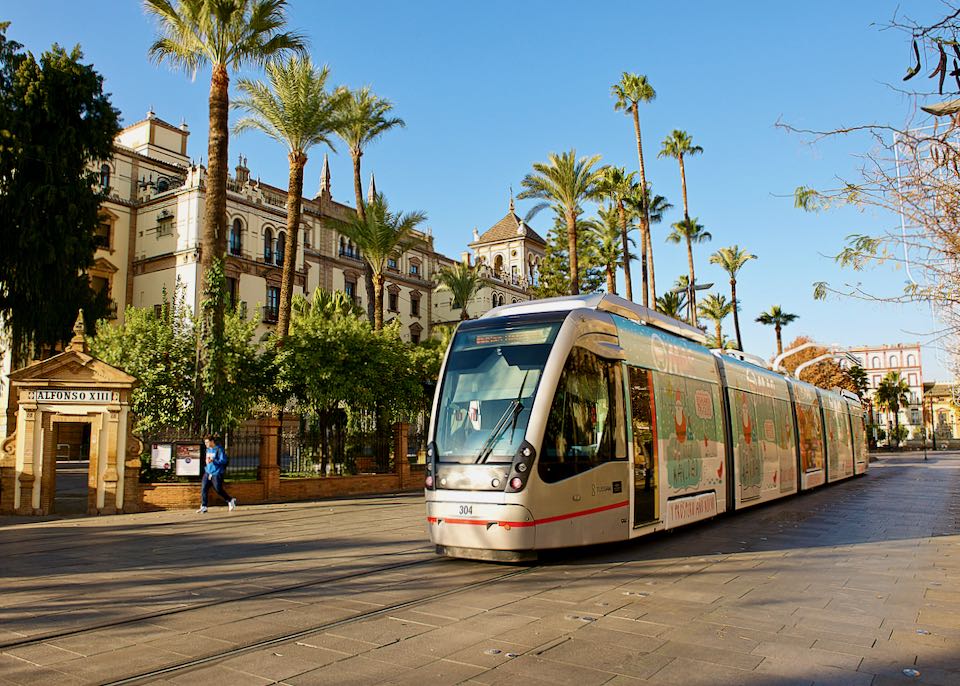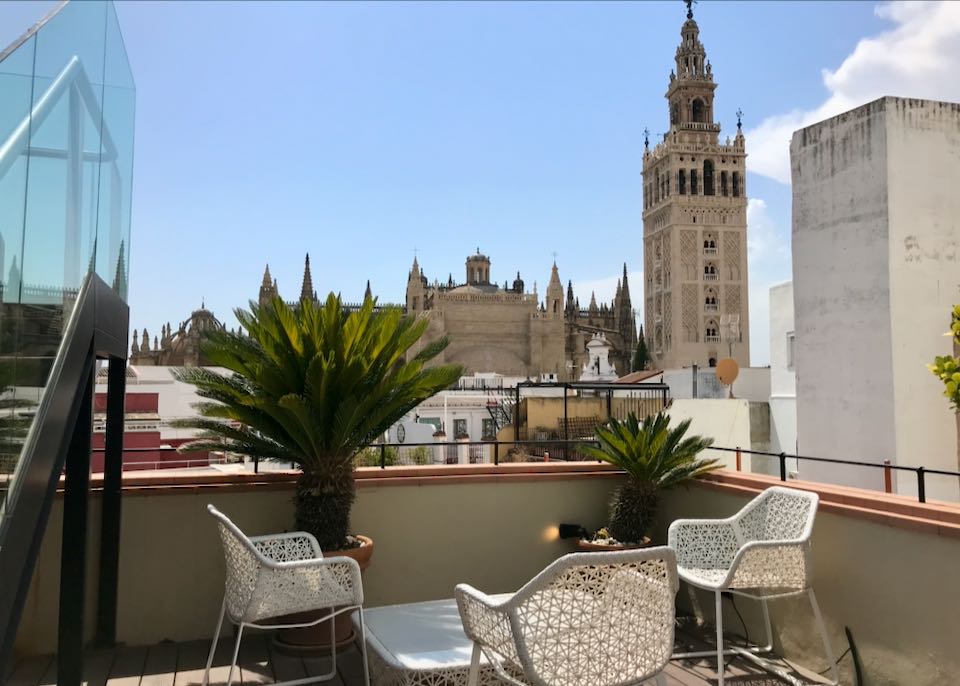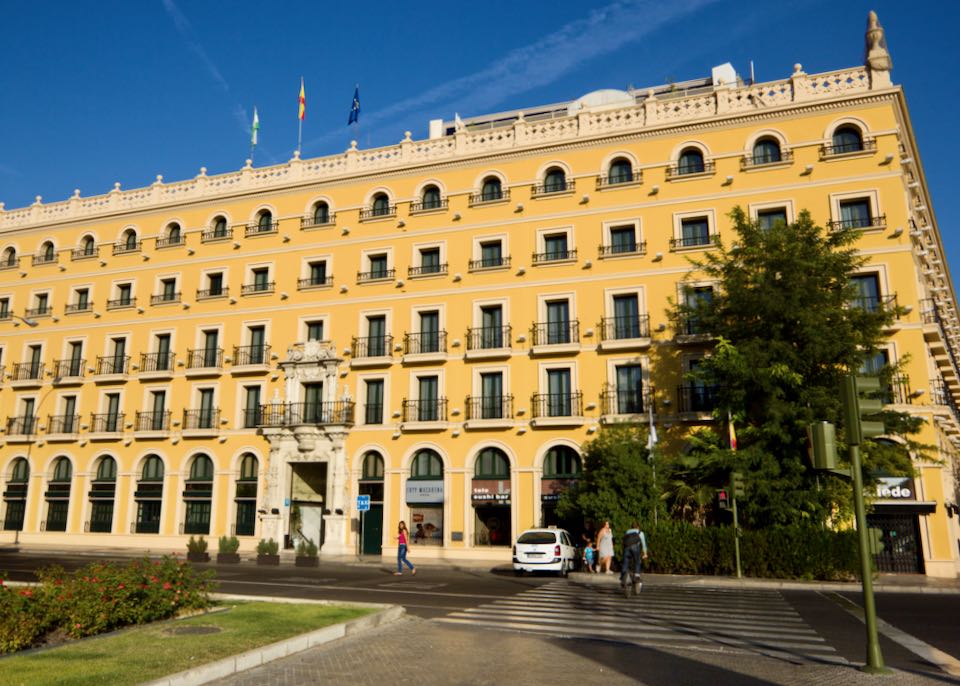Our Favorite Hotels in Seville
• 5-Star: Alfonso XIII
• 4-Star: Melia Sevilla
• 3-Star: Adriano
• For Families: Singular Virgenes
• For Couples: Mercer Sevilla

The tram passing in front of the fantastic (and central) Hotel Alfonso XIII in Seville.
The Best Areas to Stay in Seville
There is no single “best” neighborhood to stay in Seville, though some are more convenient for sightseeing than others. Since the heart of the city is compact and very walkable, and since many of Seville’s attractions are centrally located and close together, it’s perfectly feasible to stay in the neighborhood of your choice, depending on your interests and budget, and either explore the city on foot or take an inexpensive taxi, tram or metro rides to and from your hotel if you’re staying further out of the center.
Barrio Santa Cruz is the heart of Seville, centered around the cathedral. Its maze of winding streets is home to excellent, varied dining, several worthwhile museums, and much of the city’s nightlife. This is where you’ll find the widest range of accommodation in the city, from numerous boutique hotels, including 4-star and 5-star options, to excellent budget hotels. Easy to walk around, and it’s best not to drive here since many of the streets are one-way and very narrow.
Just to the west of Barrio Santa Cruz is El Arenal, Seville’s former port area that’s bordered by the river. This neighborhood is where you’ll find some of Seville’s most striking historical buildings, as well as the bull ring. Many of the city’s main attractions are minutes away on foot and accommodation here consists of a few mid-range and budget options.
To the north of Barrio Santa Cruz and El Arenal is Centre, the central part of town that sits between Plaza Nueva to the south and Plaza de la Encarnación to the north. Shopping streets and fashion chains abound here, and there are numerous restaurants and bars, as well the city’s top art museum. Accommodation includes boutique hotels, several 5-star and business hotels, and various budget options.
Bordering Centre to the north is Macarena, the northeastern part of Seville’s old city. Formerly one of the city’s poorest area, Macarena is becoming gentrified and attracting young, professional types. With several clusters of tapas bars, it has a quieter, more residential feel than Barrio Santa Cruz, and there are numerous tiny plazas and appealing churches to discover. There are numerous mid-range, self-catering options here, as well as several hotels.
Across the river from El Arenal is the up-and-coming neighborhood of Triana, renowned for its distinctive character. Flamenco was born here and now there’s a lively nightlife and a buzzy tapas bar scene, though Triana is a longish walk from Seville’s main attractions. Accommodations consist of several high end and boutique hotels, short-term apartment rentals, and a few budget hotels.
North of Triana is La Cartuja, whose defining features are a monastery with a contemporary art museum, Seville’s popular theme park and pavilions leftover from Expo 92. This is a quiet neighborhood, with very few hotels on the periphery and practically no dining options to speak of, though the tapas bars of Triana and Macarena are both within walking distance.
South of Triana is Los Remedios, a purpose-built residential district, with apartment blocks and fashion boutiques lining wide, straight avenues. Apart from several mid-range hotels, there are numerous self-catering options. Seville’s short metro line connects Los Remedios to Barrio Santa Cruz.
The Best Places to Stay in Seville

The rooftop pool at the Mercer Sevilla Hotel.
- Best Luxury Hotels in Seville
Alfonso XIII • Casa 1800 • Gran Melía Colón • Mercer Sevilla - Best Boutique Hotels Hotels in Seville
Casa del Poeta • Palacio Alcázar • EME Catedral - Best Cheap/Midrange Hotels in Seville
Alcoba del Rey de Sevilla • Adriano - Best Hotels for Families in Seville
Singular Virgenes • Apartamentos Murillo
Best Neighborhoods in Seville for Sightseeing: Barrio Santa Cruz, El Arenas, and Centre
Since these three central neighborhoods are right next to each other and imminently walkable, all three are very convenient for sightseeing. Barrio Santa Cruz is excellent for access to the biggest attractions: the Cathedral and the Alcazar. A couple of minutes’ walk away, El Arenal has its own share of attractions: the Plaza de Toros (bull ring), the historical Hospital de la Caridad, and the Torre de Oro naval museum overlooking the attractive riverside promenade. Centre is particularly good for shopping, and also for fine arts at the Museo de Bellas Artes.
Best Neighborhoods in Seville for Nightlife: Triana, Macarena, Centre, and Barrio Santa Cruz
There isn’t a single best area in Seville for nightlife. Lively pockets of nightlife dot the historical center of the city, as well as Triana. Triana is very much a local scene, with lively tapas bars open until the wee hours of the morning, particularly along Calle Betis. If you’re lucky, a local might point you in the direction of the tiny dive bars where impromptu flamenco performances still occasionally take place late at night (as opposed to in Barrio Santa Cruz, where the flamenco performances are scheduled to be around dinnertime and are largely aimed at tourists). In Macarena, the largely local action centers around tapas bars along the Alameda de Hércules and Calle Santa Ana. In Barrio Santa Cruz there are numerous tapas bars and cocktail bars to choose from in the tiny streets near the Cathedral and it’s a mixed local and tourist scene. The tapas bars and cocktail bars dotted around Centre also attract a mix of visitors and locals. There’s a handful of gay bars as well, mostly in Centre.
Best Neighborhoods in Seville for Food and Restaurants: Barrio Santa Cruz, Macarena, Triana, El Arenal, Centre
As with nightlife, there isn’t a single best neighborhood in Seville for dining out. Triana and El Arenal are renowned for their down-to-earth tapas bars where simple local dishes are beautifully executed. Macarena offers a mix of excellent tapas bars, along with some sit-down restaurants specializing in fusion cuisine. Both Centre and Barrio Santa Cruz have a mix of old-school tapas bars serving Andalusian standards, new wave gourmet tapas bars, fine dining establishments with traditional Spanish cuisine and even some international restaurants serving sushi and Indian food. Seville’s only Michelin-starred restaurant, El Abantal, is just east of Barrio Santa Cruz, en route to the train station.
Best Neighbourhoods in Seville for Families: Barrio Santa Cruz, Centre, Los Remedios
Barrio Santa Cruz is one of the best places in Seville for families because it’s a very walkable neighborhood, with fun things for kids, such as horse-drawn carriage rides and the gardens of the Alcazar. Centre is walkable, has good family-friendly hotels and is closer on foot to the Isla Magica theme park, which is across the river in La Cartuja. While Los Remedios is further out of the center and short on sights, there are good, family-friendly hotels here, as well as a large park for kids to explore.
Best Neighborhood in Seville to Stay for First Timer: Barrio Santa Cruz
If it’s your first time in Seville, then Barrio Santa Cruz is the best neighborhood to base yourself. It’s as central as it gets, very atmospheric, has an excellent dining and nightlife scene, and numerous attractions are right on your doorstep, from the Cathedral and the Alcazar to the Museo de Flamenco and the Hospital Los Venerables art gallery. It’s also the easiest place to catch a flamenco show, there’s accommodation to suit all budgets and other neighborhoods of interest – El Arenal, Centre, Macarena – are within easy walking distance.
Most Romantic Neighborhood in Seville: Barrio Santa Cruz
If you want a place to stay for a honeymoon or couple’s getaway, Barrio Santa Cruz is hard to beat. Must be something about the picture-perfect tiny streets, tiny plazas filled with orange blossoms, horse-drawn carriage rides by the Cathedral, some excellent formal dining options and intimate boutique hotels where Old World architecture meets personalized service. Though it’s also worth considering Triana, across the river, since the riverfront hotels give you splendid views of Seville’s historical center.
Best Neighborhood in Seville for a Local Vibe: Triana
It’s hard to get more ‘local’ in Seville than Triana. Still rough around the edges, this working-class neighborhood is where Seville used to produce all the beautiful ceramic tiles that you see around the city, though few ceramic workshops remain open. Many of Seville’s bullfighters, artists and flamenco performers were born here and Triana is still the best place in Seville to catch an impromptu flamenco performance in tiny dive bars late at night if you’re lucky (as opposed to in Barrio Santa Cruz, across the river, where the flamenco performances are scheduled and aimed at tourists). The cobbled streets here resemble Barrio Santa Cruz, but the houses are far less grand and the lively tapas bars along Calle Betis consistently fill with locals.
Best Neighborhood in Seville for Walking: Barrio Santa Cruz
This neighborhood consists of a maze of numerous tiny streets lined with bars, shops, and restaurants that are a pleasure to explore on foot. There is little in the way of traffic and some streets are entirely pedestrian. Barrio Santa Cruz is part of the old city and is the historical heart of Seville. You’ll find Seville’s main attractions – the Cathedral and the La Giralda belltower – right there, with the Alcazar (royal palace) directly opposite. The Hospital de la Caridad, the Plaza de Toros (bull ring) and the Torre de Oro in El Arenal are a five to ten-minute walk west, while the Flamenco Museum on the edge of Centre is a 10-minute walk north. The Museo de Bellas Artes in Centre is a 15-minute walk north and it takes around 20 minutes to reach the tapas bars of Macarena (north of Centre) or the plazas and churches of Triana – the latter being across the river: take the Puente de Triana west.
Safest Areas of Seville
Seville’s safest neighborhoods tend to be the more upmarket ones. Barrio Santa Cruz, Centre, El Arenal, Macarena, Los Remedios – all these are largely safe to walk around any time of day, though precautions apply at night. In Barrio Santa Cruz and Centre, things can get rather lively on weekend nights.
Unsafe Areas of Seville
Parts of Triana can be sketchy at night; it’s best to stick to the more popular streets where locals are out and about until late at night. In Barrio Santa Cruz, El Arenal, and Macarena it’s best to avoid any poorly lit, deserted little streets at night and it’s always a good idea to keep an eye out for opportunistic pickpockets. Parks are also best avoided at night, as is the area just to the east of Barrio Santa Cruz, between the barrio and the train station.
The 7 Best Neighbourhoods in Seville for Tourists

The view of central Seville from the Casa 1800 Hotel in Barrio Santa Cruz.
1. Barrio Santa Cruz
Bordered by El Arenal to the west and Centre to the north, the most visited part of Seville comprises a medieval maze of tiny, winding streets, lined with picturesque whitewashed houses and dotted with tiny plazas filled with orange trees. This used to be the Juderia (Jewish quarter) and the churches here were originally synagogues. The barrio’s central feature is the splendid Cathedral and the Giralda – the bell tower that used to be a minaret. The Alcazar (royal palace) is a heavyweight attraction just south of the Cathedral. The Archivo de Indias, which houses all the documents about Spain’s conquest of the New World, is also near the Cathedral and open to the public. Flamenco enthusiasts shouldn’t miss the excellent Museo de Flamenco where you can catch nightly performances of the passionate dance. Barrio Santa Cruz has a superb dining scene catering to all tastes; Calle Mateas Gago, in particular, is lined with excellent tapas bars and smart restaurants.
• Best Hotels: Alfonso XIII • Casa 1800 • Las Casas de la Juderia • EME Catedral
2. Centre
This central part of the Old City sits between Barrio Santa Cruz and Plaza Nueva with Seville’s town hall to the south and Plaza de Encarnación and Macarena to the north. Centre’s main attraction is its large shopping zone, centered around Calles Sierpes, Cuna and Velazquez/Tetuan, where you can find high street Zara, Sfera, Pull & Bear and Mango offerings, as well as some superb Spanish-made leather goods – shoes, purses, and boots. At night, Centre’s tapas and cocktail bars get seriously lively. It’s worth visiting Plaza de Encarnación to go up the Metropol Parasol – a wooden construction resembling giant mushrooms above some excavated Roman ruins; you get a great view of the city from the top. Towards the river is the Museo de Bellas Artes – Seville’s excellent fine arts museum.
• Best Hotels: Gran Melía Colón • Hotel Gravina 51
3. El Arenal
Sandwiched between Barrio Santa Cruz to the east and River Guadalquivir to the west, El Arenal used to be the port from which Spain’s ships sailed to the New World. The main attractions here are the Moorish Torre del Oro – the naval museum overlooking the river promenade, the Plaza de Toros de la Maestranza – Spain’s most famous bullring, and the Hospital de la Caridad, formerly a charity hospital for the poor, decorated with beautiful tile work and paintings by Spanish Masters. The streets are dotted with some excellent, low-key tapas bars, and there are superb views of Triana from the riverbank.
• Best Hotels: Alabardero • Mercer Sevilla
4. Macarena
Formerly a poor slum, the barrio of Macarena sits north of Centre in the old city. Its narrow streets are lined with characterful historical buildings, crumbling old mansions that have been restored and clusters of tapas bars popular with locals. The tiny plazas are dotted with churches, the most famous of which is the Basilica de la Macarena; during Semana Santa, the procession leaving this church with the statue of the Virgin on a solid silver float is one of the week’s highlights. This neighborhood attracts artists and young professionals and there’s an authentic feel to it, in spite of a certain amount of gentrification. Macarena is an easy walk from attractions in Centre, Triana and Barrio Santa Cruz.
• Best Hotel: Abril • Exe Sevilla Macarena

The 4-star Exe Sevilla Macarena Hotel.
5. Triana
Across the river from El Arenal, the main attraction of this neighborhood is wandering its streets and small plazas and exploring its ceramic workshops that still produce colorful tiles that decorate many of the city’s buildings. The tapas bars are an attraction in their own right, with many concentrated along the Calle Betis that parallels the waterfront. Seville’s heavyweight attractions in El Arenal and Barrio Santa Cruz are a 20-minute walk away.
• Best Hotel: Ribera de Triana
6. La Cartuja
The 15th-century Monasterio de la Cartuja sits in the center of this quiet part of town, north of Triana and west of the river. CAAC (Centro Andaluz de Arte Contemporaneo) – Seville’s excellent contemporary art museum resides in the monastery grounds and Columbus himself planned his voyages to the New World at the monastery, which is why the La Cartuja neighborhood was chosen to host Expo 92. There are some attractive botanical gardens near the monastery and by the river, as well as pavilions leftover from Expo 92, in one of which there are interactive displays, charting Spain’s voyages of exploration. North of the Expo 92 grounds is Seville’s large and popular theme park, Isla Mágica.
• Best Hotel: Barceló Sevilla Renacimiento
7. Los Remedios
South of Triana and reachable from Barrio Santa Cruz via a short, handy metro line, Los Remedios is an affluent residential area, its wide, straight street contrasting with the medieval maze of the old city. There’s some good shopping here, as well as a large and pleasant park – Parque Los Principes – but the neighborhood’s main draw is its proximity to the vast fairground where the Feria de Abril takes place. This exuberant, week-long celebration happens two weeks after the Semana Santa and involves costumed parades and street parties.
• Best Hotel: Monte Carmelo
About Santorini Dave